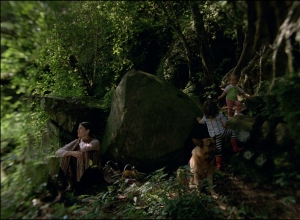The Quest for the Bevel
“A bevelled edge refers to an edge of a structure that is not perpendicular to the faces of the piece.” Good old Wikipedia, providing perhaps the most succinct analysis of the thematic and visual dualities that are intrinsic to Post Tenebras Lux.
Much like Peter Taylor’s “Post Tenebras Googling” for Ballesteros, I also jumped online after the credits to find out how Reygadas crafted these refracted and distorted exterior shots. Searching went something like “Post Tenebras Lux Lense//Post Tenebras Lux Double Exposure//Post Tenebras Lux 1:33 Distortion.” My enquiry ended pretty abruptly when I stumbled on an interview with Reygadas, where he claimed to have shot the film with “a unique lens, without a name” bevelled at the edges. Mystery it seemed was seeping out of the film itself post-Post Tenebras Lux.
This mysterious bevelled lense used by Reygadas dominates almost all of the films exterior shots, contrasting then with the familial interactions that take place between Juan and his family, and concomitantly lending the latter group of images a flattened texture. Within many of these exterior shots, as characters move towards the edge of the 1:33 frame, they become refracted by the bevelling- distorting their appearance, morphing their limbs, and occasionally creating a shadow of themselves.
Why then the removal of the bevelled lense for interiors? It’s easy perhaps to suggest that the bevelling lends the image an aesthetic nicety, and given Reygada’s preoccupation with the natural world he is simply offering a beautification of this in his “nature dominant” exterior shots. Perhaps easier still is the suggestion that the bevelled refraction functions better in wider shots, not suited to tighter framing within interior locations. Indeed we can even more easily suggest that Reygadas is setting in motion a dialectical relationship between the beauty and horror of nature and domesticity respectively.
Though perhaps the reason is more simple than all these. Perhaps Juan’s character can be understood as intrinsically bevelled. The edges of his being, his extremes of violence and addiction, do not match the domestication he strives for- the edges of Juan’s character are not perpendicular to his flattened outward projection of harmoniousness- they are bevelled, he is bevelled, and ultimately this is what destroys him. Within these interior domestic interactions, the visual bevel is replace by a human, bevelled. Through Post Tenebras Lux the edges of Juan’s character fall away, bevelled into oblivion.
*
Patrick Brian Smith is an MA Film Studies graduate from King’s College London and film critic for The Quietus. “Thanks go to Katie Smith, her photography knowledge pointed me in the bevel direction.”

